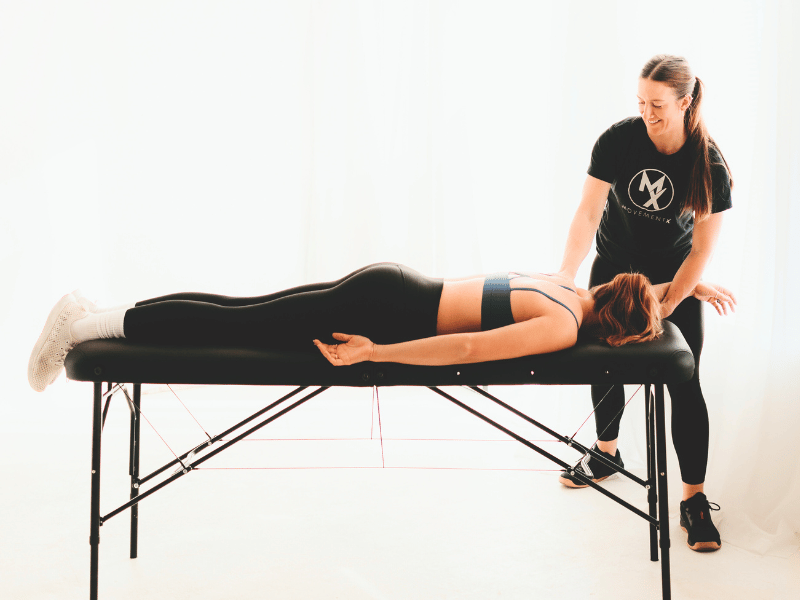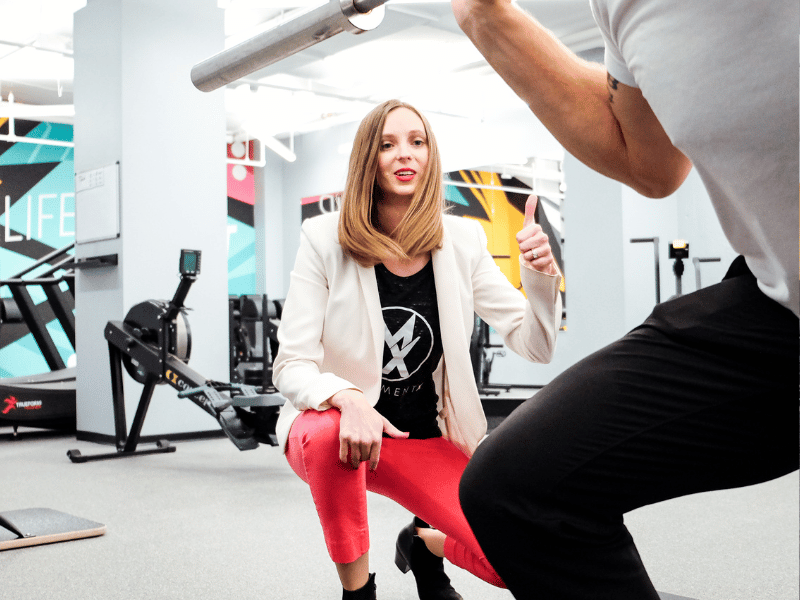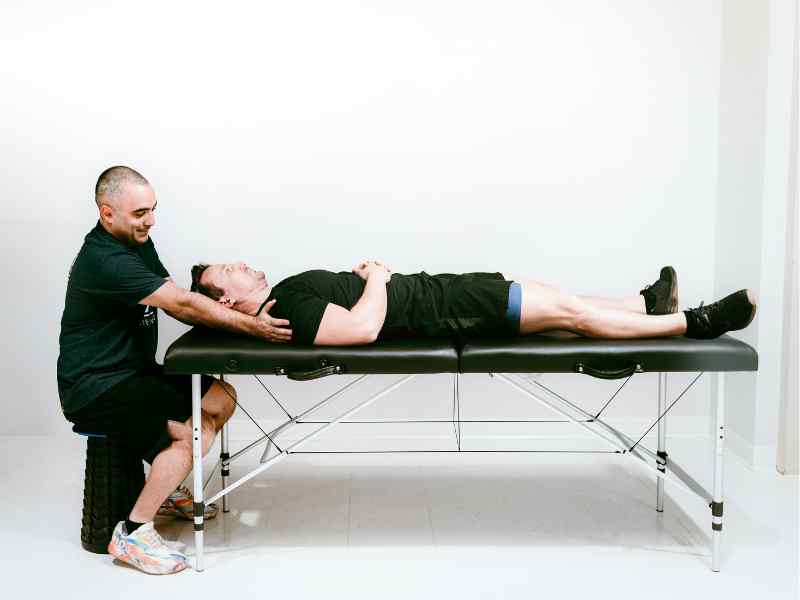Healing Your Rotator Cuff Tear: How Physical Therapy Helps You Recover
Whether you’re an athlete, an active older adult, or someone dealing with wear and tear from daily activities, a rotator cuff tear can make everyday activities very challenging.
The rotator cuff is a group of muscles and tendons that stabilize your shoulder joint and help you move your arm. Rotator cuff injuries, ranging from minor strains to full tears, are incredibly common. In fact, research shows that rotator cuff tears affect around 20% of the population, with this number increasing significantly as we age. Many people may not even realize they have a tear until it starts to affect common movements like reaching overhead, lifting objects, or raising your arm.
This article will help you understand what a rotator cuff tear is, why it happens, and most importantly, how physical therapy can play a pivotal role in your recovery. By reading on, you’ll learn how a movement-based approach can help you regain shoulder strength, improve mobility, and reduce pain.
What is a Rotator Cuff Tear?
A rotator cuff tear occurs when one or more of the tendons in the rotator cuff—the group of four muscles responsible for stabilizing and moving the glenohumeral (shoulder) joint—becomes damaged or torn. These tendons attach the muscles to the bones in the shoulder and enable a wide range of movements.
There are two primary types of rotator cuff tears:
- Partial tears, where the tendon is frayed or damaged but not completely severed, and
- Full-thickness tears, where the tendon has been torn completely away from the bone.
Symptoms of a Rotator Cuff Tear
A rotator cuff tear can manifest with a range of symptoms, depending on the severity of the injury and whether it’s a partial or full-thickness tear. Some people may experience immediate discomfort, while others may have only mild symptoms that can sometimes worsen over time. Recognizing the signs early can help prevent further issues and allow you to seek appropriate treatment.
Common symptoms associated with a rotator cuff tear are:
- Shoulder pain: This is often felt deep within the shoulder and can be dull, sharp, or throbbing sensation.
- Weakness in the shoulder: You might find it difficult to lift or rotate your arm, especially during activities like lifting objects or combing your hair.
- Reduced range of motion: Simple movements, such as reaching behind your back or overhead, can become restricted or painful.
- A clicking or popping sensation: Some people report feeling a popping sensation when moving their shoulder.
- Nighttime pain: Pain can worsen when lying on the affected shoulder, which can disrupt your sleep or make it difficult to find a comfortable position.
- Tenderness: The front or side of your shoulder may become tender to the touch.
- Gradual onset of symptoms: In cases of degenerative tears, symptoms can develop slowly with mild discomfort that worsens over months or years.
These symptoms may vary in intensity, and not everyone will experience all of them. If you notice ongoing pain or difficulty with shoulder movement, seeking a physical therapy evaluation is an important step in determining whether a rotator cuff tear is present.
Causes of Rotator Cuff Tears in the Shoulder
While in some cases a rotator cuff tear can occur suddenly from a traumatic event, in other cases it may develop gradually due to long-term wear and tear. Understanding the common causes and risk factors can help you optimize how you manage your symptoms. Common causes and risk factors include:
- Overuse and repetitive motions: Repeated overhead movements, such as those used in sports like tennis or in jobs that require lifting, can put extra strain on the rotator cuff. This repetitive stress can weaken the tendons and lead to tears over time without proper conditioning.
- Aging and degeneration: As we age, the tendons in our rotator cuff may naturally weaken and lose elasticity. Degenerative tears are more common in individuals over 40 and can result from years of normal use or minor injuries.
- Trauma or injury: A rotator cuff tear can also occur suddenly from a traumatic event, such as a fall, a car accident, or lifting something too heavy. These types of tears are more likely to be complete and can cause immediate pain and loss of function.
- Poor posture: Chronic poor posture, such as slouching or rounded shoulders, can alter the positioning of the shoulder joint.
- Shoulder impingement: This condition occurs when the rotator cuff tendons become pinched or irritated during movement. Impingement can increase the risk of a tear by creating constant friction on the tendons.
- Family history: There may be a genetic component to rotator cuff tears, as some people are more predisposed to developing tendon issues based on their family history.
While these factors can increase your risk of a rotator cuff tear, it’s important to remember that the condition can occur in people without any clear cause or warning signs.
Treatment Options for Rotator Cuff Tears
Proper treatment for a rotator cuff tear depends on the severity of the tear, your overall health, and how the injury is impacting your daily life. The goal of treatment should be to reduce pain, restore shoulder function, and prevent further damage. Below are the most common treatment options for a rotator cuff tear:
- Rest and activity modification: In the early stages of a rotator cuff injury, avoiding activities that cause pain can help minimize strain on the shoulder and give the tendons time to heal.
- Physical therapy: Physical therapy plays a central role in treating both partial and full-thickness rotator cuff tears. A personalized rehabilitation program can help strengthen the muscles around the shoulder, improve range of motion, and reduce pain. Physical therapy for rotator cuff tears is particularly effective for partial tears and allows many patients to return to daily activities without surgery.
- Anti-inflammatory medications: Over-the-counter nonsteroidal anti-inflammatory drugs (NSAIDs) can help manage pain and inflammation. While medications don’t heal the tear, they can sometimes make it easier to engage in physical therapy and daily activities.
- Corticosteroid injections: For those with severe pain or inflammation that isn’t relieved by medications, your physician may recommend a corticosteroid injection into the shoulder joint to provide temporary relief. This can help reduce pain enough to engage in physical therapy, but repeated injections are typically avoided to prevent weakening the tendon.
- Surgery: Surgery may be recommended If conservative treatments like physical therapy fail to improve symptoms after several months or if a full-thickness tear is causing significant loss of function. Surgery is often followed by a structured physical therapy rehab program to restore strength and mobility.
- Alternative treatments: Some patients explore alternative therapies like acupuncture or massage to complement their treatment. While these approaches may provide pain relief or stress reduction, they are typically not considered primary treatments for a rotator cuff tear.
Physical therapy stands out as a highly effective, non-invasive option that can help many people recover without the need for surgery. In the next section, we’ll explore in more detail how physical therapy can benefit those with a rotator cuff tear and speed up recovery.
How Physical Therapy can help after a Rotator Cuff Tear
Physical therapy is one of the most effective ways to treat a rotator cuff tear. It can help to restore strength, mobility, and function without surgery. When you work with a skilled physical therapist for a rotator cuff injury, your treatment should be tailored to your specific needs. Therefore, your therapist will start with a comprehensive assessment of your shoulder’s range of motion, strength, and overall function to create a personalized plan for your recovery.
One of the main approaches in physical therapy for rotator cuff tears involves targeted exercises to strengthen the muscles around your shoulder joint. By improving the strength and endurance of the rotator cuff muscles—as well as surrounding muscles like the deltoid and scapular stabilizers—you can regain stability and reduce strain on the injured tendon.
PTs also incorporate gentle stretches to improve shoulder mobility and reduce stiffness. Manual therapy techniques, such as joint mobilization and soft tissue massage, may also be used to decrease muscle tightness, reduce pain, and improve circulation in the affected area. This hands-on approach helps to restore proper shoulder mechanics and make arm movements more fluid and less painful.
Additionally, your PT will liely focus on restoring proper movement patterns to prevent further injury. This might include correcting poor posture or adjusting how you perform daily tasks to minimize shoulder strain. Throughout your treatment, education plays a key role to help you understand how to safely progress through recovery and avoid painful movements.
By engaging in a structured physical therapy program, many people with rotator cuff tears can regain strength, restore function, and return to their normal activities without the need for surgery.
Our Top Exercises & Stretches for Rotator Cuff Tears
Incorporating targeted exercises and stretches into your routine can play a key role in managing a rotator cuff tear. Below are three highly effective exercises that are often recommended for people dealing with a rotator cuff tear. However, it’s always best to consult with a MovementX physical therapist before starting any new exercise program to ensure they’re appropriate for your specific condition.
1. Pendulum Swings
Pendulum swings are a gentle exercise that can help improve shoulder mobility and reduce stiffness without putting too much strain on the rotator cuff.
How to perform:
- Stand beside a table or sturdy chair and place your unaffected arm on the surface for support.
- Lean forward slightly, letting your injured arm hang down toward the floor.
- Gently swing your arm in small circles, moving it clockwise for 20-30 seconds, and then counterclockwise for the same amount of time.
- Keep the movement slow and controlled, using the momentum of your body to move the arm. Avoid forcing any motion.
2. Scapular Retractions
Strengthening the muscles around the shoulder blade (scapula) can help stabilize the shoulder joint, taking pressure off the injured rotator cuff tendons.
How to perform:
- Sit or stand with good posture, keeping your shoulders relaxed.
- Squeeze your shoulder blades together as if you’re trying to pinch something between them.
- Hold the position for 5 seconds, then release.
- Perform 10-15 repetitions, making sure your shoulders stay down and don’t rise up toward your ears.
3. Doorway Stretch
The doorway stretch helps to gently improve shoulder flexibility and reduce tightness in the front of the shoulder.
How to perform:
- Stand in a doorway with your arms at a 90-degree angle, elbows bent, and forearms resting on the sides of the door frame.
- Step one foot forward and gently lean into the doorway until you feel a stretch across your chest and the front of your shoulders.
- Hold the stretch for 20-30 seconds, then relax and repeat 2-3 times. Make sure to keep the movement gentle and controlled, avoiding any sharp pain.
Disclaimer: Always consult with a MovementX physical therapist before starting any new exercise or stretch routine to ensure it’s safe and appropriate for your condition. A therapist can provide personalized guidance to help you recover safely and effectively.
Preventing Rotator Cuff Tears
Preventing rotator cuff tears best involves a combination of strength training, flexibility exercises, and proper technique. Here are some actionable tips and strategies to reduce the risk of a rotator cuff injury:
- Strengthening Exercises: Perform internal and external rotation exercises with resistance bands to strengthen the rotator cuff muscles.
- Flexibility and Mobility: Incorporate shoulder stretches like the cross-body shoulder stretch described above to maintain flexibility.
- Proper Technique and Ergonomics: Use correct form when lifting weights or performing overhead activities to avoid stressing the shoulder.
- Gradual Progression: Increase exercise intensity gradually to prevent overloading the rotator cuff.
- Strength Imbalance Corrections: Balance the strength of front shoulder muscles with the rotator cuff and back muscles to maintain overall shoulder stability.
- Regular Assessments and Professional Guidance: Consult a physical therapist to tailor exercises and assess shoulder mechanics for personalized prevention strategies.
Conclusion
In conclusion, a rotator cuff tear can significantly impact your daily life, but effective recovery is within your reach! Understanding the nature of this injury and how physical therapy can help is crucial for regaining your shoulder strength and mobility. Have you been experiencing shoulder pain or restricted movement? Are you unsure if a rotator cuff tear might be affecting your quality of life?
If you’re struggling with discomfort or suspect a rotator cuff injury, MovementX is here to help. Our team of expert physical therapists and personal trainers can provide a personalized approach to your recovery, helping you to get back to your normal activities pain-free. Don’t let a rotator cuff tear hold you back—take the first step towards healing and improving your shoulder health today.
References
- https://www.jospt.org/doi/full/10.2519/jospt.2022.11306
Share This Page
More Conditions We Treat
Found this page interesting? Learn more about other conditions we treat:




